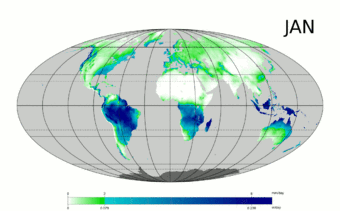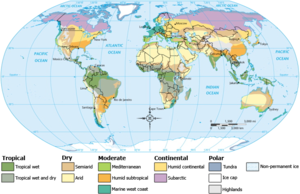- Climate of Africa
-
 Climate zones of Africa, showing the ecological break between the desert climate of the Sahara and the Horn of Africa (red), the semi-arid Sahel (orange) and the tropical climate of Central and Western Africa (blue). Southern Africa has a transition to semi-tropical or temperate climates (green), and more desert or semi-arid regions, centered on Namibia and Botswana.
Climate zones of Africa, showing the ecological break between the desert climate of the Sahara and the Horn of Africa (red), the semi-arid Sahel (orange) and the tropical climate of Central and Western Africa (blue). Southern Africa has a transition to semi-tropical or temperate climates (green), and more desert or semi-arid regions, centered on Namibia and Botswana.
The climate of Africa ranges from tropical to subarctic on its highest peaks. Its northern half is primarily desert or arid, while its central and southern areas contain both savanna plains and very dense jungle (rainforest) regions. In between, there is a convergence where vegetation patterns such as sahel, and steppe dominate. The movement of the Intertropical convergence zone, also known as the monsoon trough, creates a rainy season across central portions of the continent to the south of the Sahara. Tropical waves moving offshore Africa caused by the African easterly jet lead to many of the northern Atlantic's tropical cyclones annually. The Sahara is the hottest and driest portion of Africa due to the presence of the subtropical ridge.
Contents
Temperatures
See also: Subtropical ridgeGlobally, heating of the earth near the equator leads to large amounts of upward motion and convection along the monsoon trough or Intertropical convergence zone. The divergence over the near-equatorial trough leads to air rising and moving away from the equator aloft. As it moves towards the Mid-Latitudes, the air cools and sinks, which leads to subsidence near the 30th parallel of both hemispheres. This circulation is known as the Hadley cell and leads to the formation of the subtropical ridge.[1] Many of the world's deserts are caused by these climatological high-pressure areas,[2] including the Sahara.
Temperatures are hottest within the Sahara of Algeria and Mali,[3] and coolest across the south and at elevation within the topography across the eastern and northwest sections of the continent. The hottest average temperature on Earth is Dallol, Ethiopia, which averages a temperature of 33.9 °C (93.0 °F) throughout the year.[4] The hottest temperature recorded within Africa, which is also the world record, was 57.8 °C (136.0 °F) at 'Aziziya, Libya on September 13, 1922.[5] Apparent temperatures, combining the effect of the temperature and humidity, along the Red sea coast of Ethiopia and Gulf of Aden coast of Somalia range between 57 °C (135 °F) and 63 °C (145 °F) during the afternoon hours.[3] The lowest temperature measured within Africa was −24 °C (−11 °F) at Ifrane, Morocco on February 11, 1935.[5]
Wind
Main article: African easterly jetThe low-level easterly African jet stream is considered to play a crucial role in the southwest monsoon of Africa,[6] and helps form the tropical waves which march across the tropical Atlantic and eastern Pacific oceans during the warm season.[7] The jet exhibits both barotropic and baroclinic instability, which produces synoptic scale, westward propagating disturbances in the jet known as African easterly waves, or tropical waves. A small number of mesoscale storm systems embedded in these waves develop into tropical cyclones after they move from west Africa into the tropical Atlantic, mainly during August and September. When it lies south of normal during the peak months of the Atlantic hurricane season, tropical cyclone formation is suppressed.[8]
Precipitation
See also: Wet seasonIts northern half of the continent is primarily desert or arid, containing the Sahara, while its southern areas contain both savanna plains, and its central portion contains very dense jungle (rainforest) regions. The equatorial region near the Intertropical Convergence Zone is the wettest portion of the continent. Annually, the rain belt across the country marches northward into Sub-Saharan Africa by August, then moves back southward into south-central Africa by March.[9] Areas with a savannah climate in Sub-Saharan Africa, such as Ghana, Burkina Faso,[10] [11] Darfur,[12] Eritrea,[13] Ethiopia,[14] and Botswana have a distinct rainy season.[15] La Niña results in wetter than normal conditions in Southern Africa from December to February, and drier than normal conditions over equatorial East Africa over the same period.[16]
Within of Madagascar, trade winds bring moisture up the eastern slopes of the island, which is deposited as rainfall, and brings drier downsloped winds to areas south and west leaving the western sections of the island in a rain shadow. This leads to significantly more rainfall over northeast sections of the island than the southwestern portions of Madagascar.[17] Southern Africa receives most of its rainfall from summer convective storms and with extratropical cyclones moving through the Westerlies. Once a decade, tropical cyclones lead to excessive rainfall across the region.[18]
Snow is a rare occurrence in South Africa, with snowfall having been experienced in Johannesburg in May 1956, August 1962, June 1964, September 1981, August 2006, and on 27 June 2007,[19] accumulating up to 10 centimetres (3.9 in) in the southern suburbs.
See also
- Climate of South Africa
- Earth rainfall climatology
References
- ^ Dr. Owen E. Thompson (1996). Hadley Circulation Cell. Channel Video Productions. Retrieved on 2007-02-11.
- ^ ThinkQuest team 26634 (1999). The Formation of Deserts. Oracle ThinkQuest Education Foundation. Retrieved on 2009-02-16.
- ^ a b Christopher C. Burt (2004). Extreme Weather: a guide & record book. W. W. Norton & Company, Inc.. pp. 24–28. ISBN 0393326586.
- ^ Ronald L. Wagner and Bill Adler, Jr. (1997). The Weather Sourcebook. Adler & Robin Books, Inc.. p. 91. ISBN 1762700807.
- ^ a b Global Measured Extremes of Temperature and Precipitation. National Climatic Data Center. Retrieved on 2007-06-21.
- ^ Kerry H. Cook. Generation of the African Easterly Jet and Its Role in Determining West African Precipitation. Retrieved on 2008-05-08.
- ^ Chris Landsea. AOML Frequently Asked Questions. Subject: A4) What is an easterly wave ? Retrieved on 2008-05-08.
- ^ Climate Prediction Center (November 1997). "Figure 7". National Oceanic and Atmospheric Administration. http://www.cpc.ncep.noaa.gov/products/special_summaries/97_4/fig7.gif. Retrieved 2011-02-05.
- ^ Todd Mitchell (October 2001). "Africa Rainfall Climatology". University of Washington. http://jisao.washington.edu/data/ud/africa/. Retrieved 2010-01-02.
- ^ Patrick Laux et al. (2008): Predicting the regional onset of the rainy season in West Africa. International Journal of Climatology, 28 (3), 329-342.
- ^ Patrick Laux et al. (2009): Modelling daily precipitation features in the Volta Basin of West Africa. International Journal of Climatology, 29 (7), 937-954.,
- ^ David Vandervort (2009). Darfur: getting ready for the rainy season. International Committee of the Red Cross. Retrieved on 2009-02-06.
- ^ Mehari Tesfazgi Mebrhatu, M. Tsubo, and Sue Walker (2004). A Statistical Model for Seasonal Rainfall Forecasting over the Highlands of Eritrea. New directions for a diverse planet: Proceedings of the 4th International Crop Science Congress. Retrieved on 2009-02-08.
- ^ Alex Wynter (2009). Ethiopia: March rainy season "critical" for southern pastoralists. Thomson Reuters Foundation. Retrieved on 2009-02-06.
- ^ The Voice (2009). Botswana: Rainy Season Fills Up Dams. allAfrica.com. Retrieved on 2009-02-06.
- ^ http://www.scoop.co.nz/stories/WO1010/S00173/la-nina-weather-likely-to-last-for-months.htm
- ^ T. Andry Arivelo, Professeur A. Ratiarison, Professeur M.Bessafi, Rodolphe Ramiharijafy (2007-12-19). "Madagascar rainfall climatology: Extreme Phenomena". Stanford University. http://www.slac.stanford.edu/econf/C0709107/pdf/308.pdf. Retrieved 2010-01-02.
- ^ Pearl Mngadi, Petrus JM Visser, and Elizabeth Ebert (October 2006). "Southern Africa Satellite Derived Rainfall Estimates Validation". International Precipitation Working Group. p. 1. http://www.isac.cnr.it/~ipwg/meetings/melbourne/papers/Mngadi.pdf. Retrieved 2010-01-05.
- ^ SABCnews.com. "Joburg covered by snow as temperature drops". Archived from the original on 2007-06-29. http://web.archive.org/web/20070629130254/http://www.sabcnews.com/south_africa/general/0,2172,151555,00.html. Retrieved 2007-07-16.
Climate of Africa Sovereign
states- Algeria
- Angola
- Benin
- Botswana
- Burkina Faso
- Burundi
- Cameroon
- Cape Verde
- Central African Republic
- Chad
- Comoros
- Democratic Republic of the Congo
- Republic of the Congo
- Côte d'Ivoire (Ivory Coast)
- Djibouti
- Egypt
- Equatorial Guinea
- Eritrea
- Ethiopia
- Gabon
- The Gambia
- Ghana
- Guinea
- Guinea-Bissau
- Kenya
- Lesotho
- Liberia
- Libya
- Madagascar
- Malawi
- Mali
- Mauritania
- Mauritius
- Morocco
- Mozambique
- Namibia
- Niger
- Nigeria
- Rwanda
- São Tomé and Príncipe
- Senegal
- Seychelles
- Sierra Leone
- Somalia
- South Africa
- South Sudan
- Sudan
- Swaziland
- Tanzania
- Togo
- Tunisia
- Uganda
- Zambia
- Zimbabwe
States with limited
recognition- Sahrawi Arab Democratic Republic
- Somaliland
Dependencies and
other territories- Canary Islands / Ceuta / Melilla / Plazas de soberanía (Spain)
- Madeira (Portugal)
- Mayotte / Réunion (France)
- Saint Helena / Ascension Island / Tristan da Cunha (United Kingdom)
- Western Sahara
Categories:
Wikimedia Foundation. 2010.



